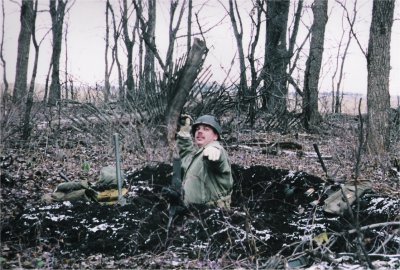105th ENGINEER COMBAT BATTALION |
|
|
105th ENGINEER COMBAT BATTALION |
|
|
 |
Home |  
 |
 |
About the 105th | |
 |
Getting Started | |
 |
Photo Gallery | |
 |
Useful Links | |
 |
History | |
 |
Calendar of Events |
Tents & Canvas: If your canvas items get wet, set them out to dry before folding them up for storage. This helps to prevent mold growth, which makes that musty smell.
HBTs: If you pick up HBTs (herring bone twill uniform) follow the instructions on the label. Wash them in warm or cold water (warm water dissolves the soap better), then hang them out to dry. If you put them in the dryer you'll end up with clothes fit for a toddler.
Wool Uniform: I recommend taking these items down to the dry cleaner. If you've just purchased a vintage uniform though I recommend a particular dry cleaner for the first cleaning: Best Cleaning & Restoration Services. They're more expensive than regular dry cleaners ($16 for a shirt and $25 for a jacket), but they know how to handle old and delicate fabrics.
Musty Equipment: Mold and mildew can be a major problem for old equipment. Often the gear has been stored in a dank garage, basement, or barn for decades - prime growing conditions for spores. If you acquire items that have a musty smell it's best to take care of the problem as quickly as possible before it spreads to the rest of your collection or your entire house. Mold can lead to respiratory problems for the residents of an infected home and seriously agravates asthma. Not a desireable condition for those of us who are married. The Commander-in-Chief will insist that either your prize new possesion goes or you get tossed with it.
Some people have suggested that airing out the item will take care of the problem. Sunlight kills mold and a good breeze will take the spoores away. What a bunch of hooey! It certainly helps to give the piece a good airing, but it's been my experience that some spoores still live deep within fabric seems, padding, joints of boxes, and the wood grain. I've left items in the sun for weeks on end, taking them inside at night and on raining days and they still stink to high heaven. What's a guy to do?
Currently I'm experimenting with tee tree oil. After two applications it's knocked the mold back quite a bit. Straps attached to a mine detector crate still have a faint smell to them. A couple of pads with a lot of stuffing in them are still pretty potent and will have to simply be tossed.
To make a solution, mix 2 teaspoons tea tree oil and 2 cups water. Combine in a spray bottle, shake to blend, and spray on problem areas. Do not rinse.
Tea tree oil is available at Whole Foods for $18 for a 2 oz bottle.
Canteen: Sometimes canteens develop a funky smell and taste in the water. This may be due to bacteria, especially if your canteen hasn't seen use for a while. You can take care of this by filling the canteen with water, add a drop of ordinary bleach, then shake well. Let it stand for a few hours, then rinse several times.
If the cork in your canteen is damaged or missing, cut a new one from the cork of a champaign bottle. It's just the right size to fit in the cap.
Store your canteen with the cap off so mold and bacteria don't get a chance to grow inside.
Rust: If an item has light rust, soaking it in Coca-Cola will do a good job of taking off the corrosion.
EE8 Telephone: Added a page on how to clean and troubleshoot your EE8 field telephone.
